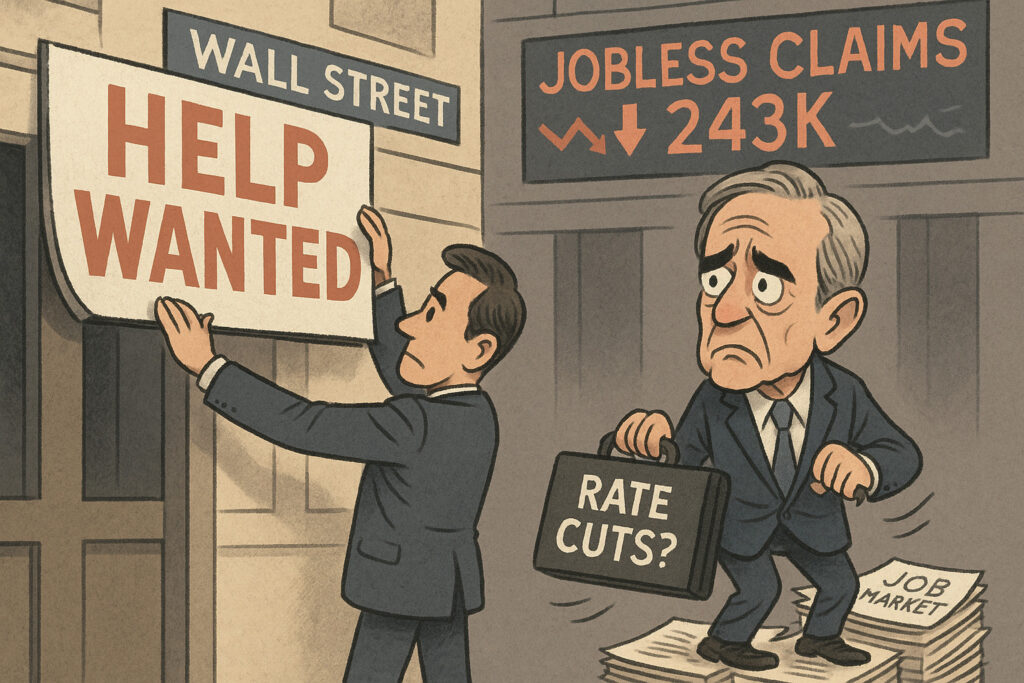The U.S. labor market — long considered the bedrock of economic resilience over the past two years — is showing its first signs of strain in 2025. On Thursday, the Department of Labor reported that initial jobless claims for the week ending March 29 rose to 243,000, marking the highest level since December 2024 and significantly above economists’ consensus estimate of 222,000. The data rattled markets, intensified speculation about the Federal Reserve’s next move, and stirred concerns that the long-feared slowdown may be setting in.
What the Numbers Say
According to the Labor Department:
- Initial jobless claims jumped by 21,000 from the prior week.
- The 4-week moving average climbed to 229,750 — its highest level since mid-January.
- Continuing claims (which lag a week behind) also ticked up to 1.87 million, their highest level since November 2023.
The spike, while not dramatic in historical terms, represents a sharp deviation from the relative stability seen in the first quarter of 2025, where weekly claims hovered comfortably below 210,000.
Market Reaction
Markets responded swiftly to the negative labor data:
- The S&P 500 slipped by 0.85%, closing at 5,212, as sentiment soured on economic strength.
- The Nasdaq Composite fell 1.24%, ending the session at 16,902, dragged down by risk aversion in growth stocks.
- Treasury yields fell across the curve, with the 10-year yield dropping to 3.96%, reflecting a flight to safety and increasing bets on Fed cuts.
- The U.S. Dollar Index (DXY) weakened to 102.1, down 0.4% intraday, on lowered rate hike expectations.
- Meanwhile, gold rallied above $2,320 per ounce, gaining over 1.2% as investors sought safe-haven assets.
Interpreting the Data: Noise or Narrative?
The spike in jobless claims is unlikely to mark a turning point on its own — one week doesn’t make a trend. However, when placed in the context of recent economic signals, including softening in hiring intentions, waning consumer confidence, and flat private payroll growth, the data could be a leading indicator of labor market softening.
Economists remain divided:
- Goldman Sachs analysts dismissed the rise as a seasonal fluke exacerbated by technical distortions from California and New York, two large states with volatile weekly claims patterns.
- Others, including Bank of America, argue the data validates their view that the Fed’s aggressive hiking cycle is beginning to take a toll on employment.
Implications for the Federal Reserve
Federal Reserve Chair Jerome Powell recently reaffirmed a “data-dependent” stance, emphasizing the need for continued labor market strength as a prerequisite for policy easing. Today’s claims report challenges that framework.
Futures markets are now pricing in:
- A 64% probability of a Fed rate cut in June, up from just 47% last week.
- Three full cuts by year-end, reflecting growing conviction in an economic slowdown narrative.
While one report will not alone alter policy, it may strengthen the dovish voices within the FOMC.
Sector & Asset Class Analysis
Equities: Defensive Rotation Begins
- Healthcare (+0.4%) and Consumer Staples (+0.3%) outperformed the broader market.
- Tech (-1.5%) and Financials (-1.2%) lagged, suffering from both risk-off sentiment and lower yields.
Fixed Income: Rally in Bonds
- Treasury prices surged, pushing yields lower.
- The 2s10s yield curve, deeply inverted, narrowed slightly but remains a signal of recession risk.
Commodities: Gold Shines
- With inflation concerns lingering and risk appetite diminishing, gold’s technical breakout above $2,300/oz could signal a sustained uptrend.
FX Markets: Dollar Under Pressure
- The dollar weakened broadly, especially versus the euro (EUR/USD +0.5% to 1.097) and yen (USD/JPY -0.6% to 146.20), as rate cut bets increased.
Final Thoughts
The rise in jobless claims may be the first real crack in what has been a remarkably resilient U.S. labor market. While it’s too early to call for a recession, the data adds weight to the argument that the lagged effects of monetary policy tightening are finally materializing.
For investors, the playbook is changing. Focus is shifting from growth momentum to defensive positioning, rate sensitivity, and capital preservation. As always, vigilance in macroeconomic signals — not panic — is key.
